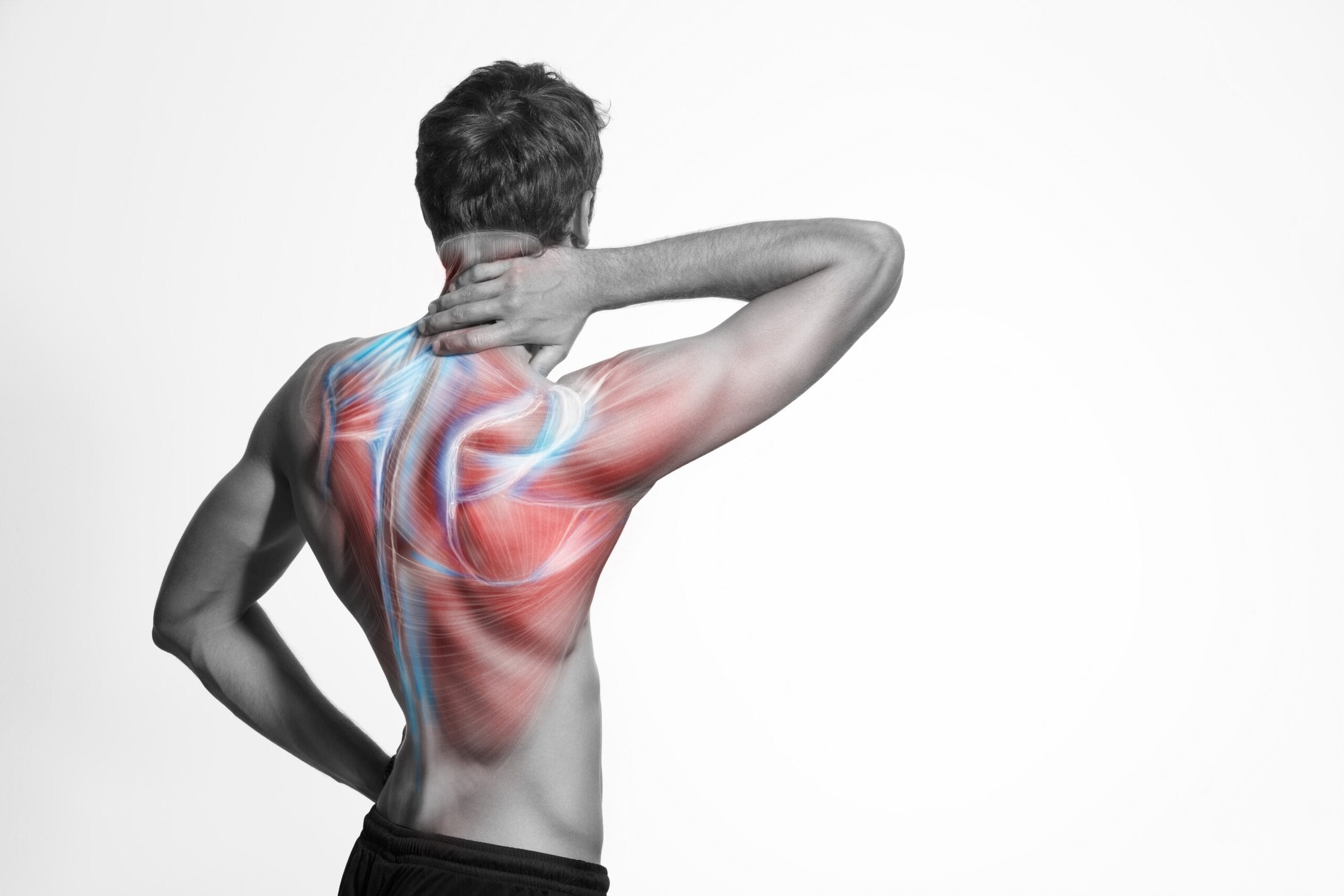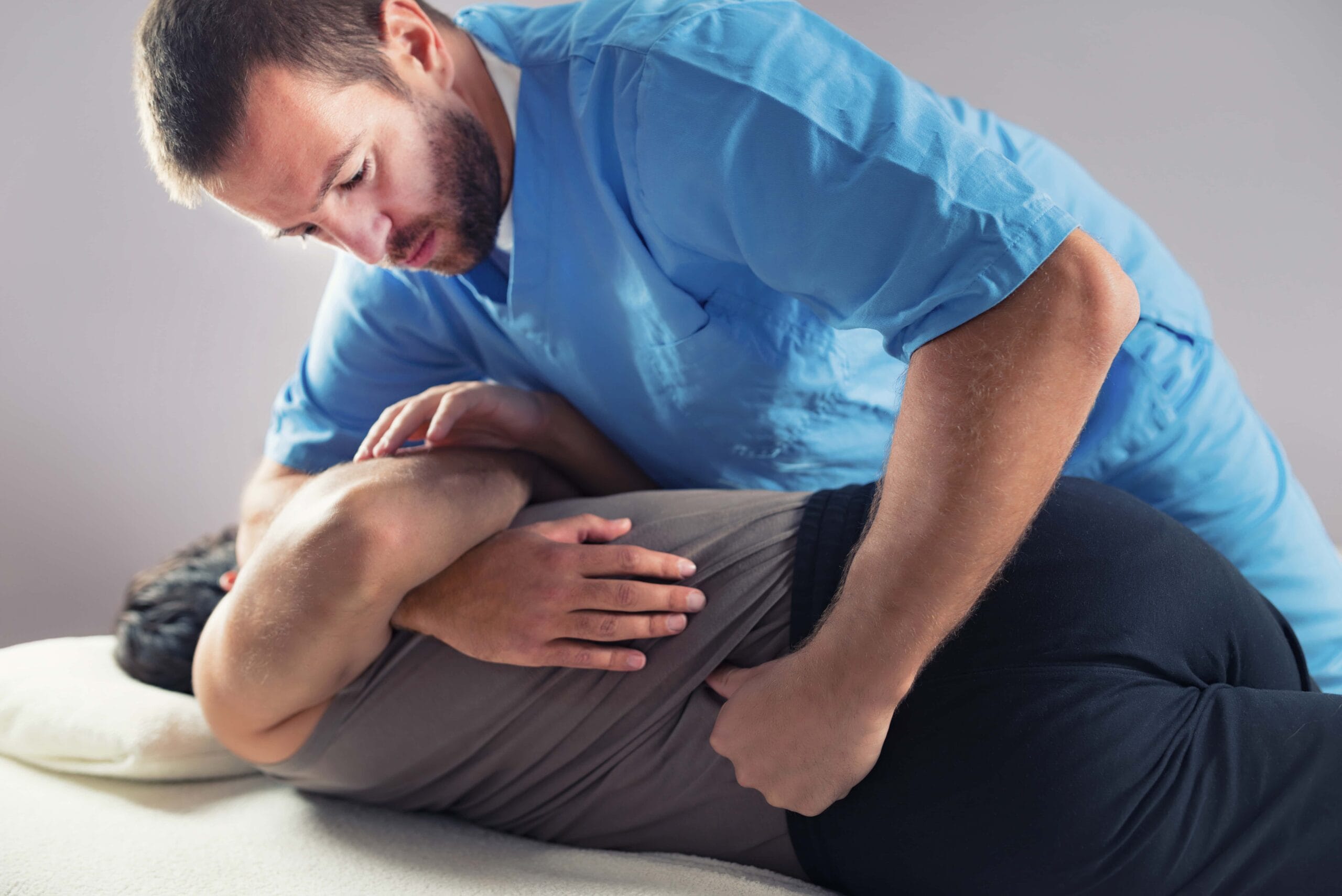Combat Arts Spine Injuries Overview
Back Injuries Stop Fighters. Kenny Floria, Matt Hughes, Matt Sera, and other UFC fighters have been pulled from action because of back injuries. Warrior combat arts are intense, and injuries can happen during training and practice, sparring, and of course, events. Combat Art participants get hurt and find it hard to stop training, and allow the healing process to occur. Phillipe Nover said that he has “definitely fought with the herniated disc a few times, that was during the UFC and it just kept getting worse and worse.” Nover’s back surgery has fixed his herniated disc issue, however, and allowed him to resume his career.

Martial artists rely on the spine for every movement ranging from kicks and strikes to throws, takedowns, and katas. Spinal strength and proper alignment are often taken for granted until an injury occurs. Exercises designed to strengthen the large and especially the small, deep muscles that support and keep vertebrae in alignment are an important aspect of martial arts training.
Many martial arts such as kung fu, krav maga, pencak silat, vale tudo, savate, kajukenbo, bacom, combat sambo, ninjitsu, san shou, full-contact karate, Brazilian jujitsu, and MMA are full-contact sports which increases the possible chance of spinal or back injury. Even those martial arts styles considered partial or non-full contact such as wing chun, kickboxing, karate, chin na, aikido, or tai chi, for instance, may cause spinal injury if practiced incorrectly.
Spine Injury Causes
Most martial arts are full-contact sports. In acute throwing and grappling sports, due to various throws or takedowns, an athlete may land on a vulnerable position on the mat.
Sometimes, rotation motion of the back with an opponent causes spinal injuries. In striking sports, it all depends on how much contact is allowed. Also, various techniques and fighting stances can lead to overuse injuries.
For new athletes, who are still learning the correct technique, the predilection to injury is much higher. Some martial arts will dedicate weeks training athletes the correct method of falling.
Falling awkwardly can injure the back. Adolescents tend to have higher rates of sports-related back injuries. For those who don’t practice any back muscle strengthening and core strengthening, back injuries are worse.
The muscles of the back and the core muscles support the spine. Injury or weakness of these muscles also tends to increase spinal vulnerability. Overstretching the muscles can also cause back spasms. A lack of warm-up also affects the muscles and ligaments of the back.
Full contact demands sudden movements for which the muscles are unprepared without a warmup. These muscles need time for blood circulation to increase and loosen up the joints and ligaments. The increased blood flow only happens after a gradual increase in heart rate through warm-up exercise.
Spine Injury Symptoms



Types of Spine Injuries
Some injuries to the spine are due to overuse as the load on the ligaments accumulates over time, wearing them down. Other moves require full body rotation, so a considerable amount of torque is applied to the spine. These may yield micro damages at first.
And later as the damage accumulates, macro damage occurs. Acute injuries result from falling awkwardly and direct strikes to the back. There is no protective combat gear for the spine except for the mat and correct technique by the opponent.
Overstretching Muscles Can Cause Back Spasms
Want to Understand Other Causes of Back Pain?
Here are some common injuries:



Related Injuries
This occurs when the vertebrae in the neck or back are squeezed, compressed, crushed, or broken. Vertebrae bones collapse from pressure creating painful compression and injury. The incidence of catastrophic injury in MMA is recorded as lower than that of many other sports, including football and cheerleading.
Causes
Vertebral fractures have occurred in MMA or other martial arts events from triangle chokes or guillotine chokes performed incorrectly, not immediately tapped out, or through the martial artist attempting to do takedown while in a chokehold.
Symptom
The most immediate and obvious symptom of vertebral fracture will be an extreme pain in the back or neck. Basic symptoms for vertebral fracture include:
To Learn How Vertebral Fractures is Diagnosed Click Here
Herniated discs are also called ruptured disks or slipped disks. The spinal column is comprised of separate vertebrae bones with cushioning discs between them that are shaped like donuts, called the annulus, with a soft jelly-like substance in their center, the nucleus, which allows movement without bone-on-bone rubbing. A herniated disk means one of the cushioning discs has ruptured and the nucleus is pressed out of the tear. A herniated disc may occur anywhere along the spine, but it most commonly happens in the lumbar or lower spine, in the cervical spine or neck.
Symptoms
A slipped or herniated disc typically causes immediate pain at the time of injury, although some people experience no pain or symptoms. There may be no pain at the original site of injury but nerves closest to herniation may become inflamed or weak, creating issues in an arm or leg, for instance, from a herniated disc in the neck or back.
Common symptoms include:
The nerves closest to herniation may become inflamed or weak, creating pain, numbness, or tingling in the extremities. Common symptoms include:
Causes
A herniation occurs when the martial artist exerts too much force on a part of the spine. For example, when the martial artist weighing 144 pounds incorrectly throws the opponent weighing 250 pounds and herniates a spinal disc during the execution of the move by applying too much pressure on the lower spine.
To Learn How Herniated Disc is Diagnosed Click Here
The spinal cord is a long, thin bundle of nervous tissue, extending from the base of the brain through the lumbar vertebrae. A spinal cord injury means that direct trauma occurred to the vertebrae which protects the spinal cord or directly to the spinal cord itself. A spinal cord injury results in loss of mobility or feeling.
"Spinal cord injury is basically any trauma to the spinal cord that interrupts the flow of [electrical] information from the brain to wherever the nerves are going," said Dr. Salvatore Insinga, chief of neurosurgery at Southside Hospital in Bay Shore, New York. Less than 10% of all spinal cord injuries occur as a result of sports participation. A spinal cord injury may be partial or complete and is a medical emergency requiring immediate doctor care.
Bruce Lee Almost Breaks His Spine. Bruce Lee was lifting his usual intensely heavyweights of 135 lbs. early one morning in 1970 when he heard a pop and injured the 4th sacral nerve in his back. Doctors said he’d never kick, do martial arts, lift weights or even walk again. Lee began exercising after 6 months of recovery time and quickly returned to top form acting in four films with only occasional back pain. Lee said the reason for the injury as he did not perform his normal stretching routine that morning before lifting.
Depending on the type and severity of spinal cord injuries, healing may or may not occur. In less severe cases where healing may be possible, inexperienced first aid may cause paralysis. Do not move the injured person. Immediately call an emergency ambulance. Never try to move a person suspected of having a spinal cord injury. Get expert help. There are medical protocols that are followed in the case of SCI that depend on the severity and location of the injury. Call for an ambulance.
Spinal cord injury symptoms are varied depending upon the location and severity of the injury. Symptoms of a spinal cord injury do not always show up immediately.
Spinal cord injuries in martial arts are rare. They may occur while doing triangle or guillotine neck chokes, or when throwing an opponent incorrectly results in the head, back, neck, or spine hitting a hard surface. Examples include:
MMA Fighter Paralyzed During Training. Devin Johnson was only 22 years old and an MMA fighter when practicing to escape a guillotine choke left him with C4-5 neck or cervical spine fracture and spinal-cord injury which has left him paralyzed from the neck down.
To Learn How SCI are Diagnosed Click Here
Most people habitually live, move, and train while in bad spinal and body alignment. This is especially true of people who work at desks, drive often, stare down at cell phones a lot, or watch a lot of TV. Most martial artists rely too much on their back and arm muscles, and not enough on proper stance and core muscles. This leads to back problems, and especially alignment issues. The most common martial arts to have a spinal misalignment and improper body alignment are MMA, Tae Kwon Do, and other hard martial arts.
Proper spinal and body alignment is a dynamic concept that must constantly be sought, especially during fight events when the body is pushed to the limit. Constantly readjusting to keep proper alignment of knees, ankles, feet, back vertebrae, shoulders, and neck is an essential element of martial arts.
This process of alignment awareness eventually becomes automatic when done correctly and consistently. It strengthens muscles and joints while protecting the body from injury. Proper alignment means the knee is always pointed in the same direction as the toes, with the hips, knee, ankle, and foot stacked. No inner rotation of the knee is allowed, and the knee should never extend forward past the toes.
Martial artists should always be able to see their toes when looking down at the feet. When the knee obstructs viewing the foot, the knee may be bent forward past the foot which harms tendons, cartilage, and other vital parts of the knee even when no pain is present. Martial artists who do not stay aware of alignment over time will find damage silently occurs until ‘suddenly’ the martial artist experiences pain in the knees, damages cartilage, develops back pain, or tears a ligament while doing a takedown, for instance.
Proper body alignment relies on the core muscles of the stomach to support the torso and the legs while in motion and during vertical changes. Soft martial arts, like Tai Chi, Ninjutsu, and Aikido have a smaller risk of spinal damage because the emphasis is on proper alignment instead of power.
Any sharp movement of the spine could potentially cause a misalignment. Sudden shocks to the body have a higher potential of causing a misalignment. Repeated poor posture or incorrectly practiced stances can cause habits creating physical stresses that cause a misalignment. Jiu-Jitsu fighters grappling for a hold or submission may twist the spine out of place, pinching nerves between bones, and causing sciatica. A kick to the head may miss and throw the fighter off balance, or a swift headlock that twists and crushes vertebra while the spine is twisted could impinge a nerve in the neck.
The most common place for a pinched nerve to occur is in the lower back, where it presses upon the sciatic nerve which runs from the lower back into the leg and often leads to sciatica or pain which travels from the lower back down into the hip or leg. The second most common type of pinched nerve occurs in the neck where it results in pain radiating down the arm, weakness, and compromised reflexes. Carpal tunnel syndrome is another very common type of pinched nerve and occurs in the median nerve at the wrist.
Examples include:
To Learn How Vertebral or Spinal Misalignment are Diagnosed Click Here
It’s easy to ignore back sprains and strains since a majority of fighters attribute it to bad technique or incorrect warm up. UFC fighter Anderson Silva who is known as “The Spider” experienced lower back pain after a jiu-jitsu session.
A back sprain is overstretching of the ligament while a back strain is an injury to the muscles and tendons of the back. Luckily, for Silva, what he assumed was a back sprain escalated quickly. Within minutes he couldn’t feel his legs or move his feet. The pain was so severe that he believed he would be paralyzed. The doctors ruled he had lower back pain from training and was cleared to return to play only ten days later.
However, his leg still hurts. The simple back sprain produced symptoms that were reversible but also severe. Not everyone who has back sprain or back strain will have symptoms as severe as Silva but it’s a careful reminder that the spinal column and its accompanying nerves can experience trauma and produce dangerous neurological sequelae.
The back is a very complex structure. The spinal column is supported by vertebral bones. Cartilage acts as a shock absorber between each vertebral body. Tendons, ligaments, and muscles attached to the vertebral column suspend it be connecting to the hip bones, the occiput, the shoulders, arms, and abdomen.
This is an intricate network of connective tissue that holds an athlete’s back up. The lower back is more susceptible to injury in full-contact sports because it bears the brunt of the weight, the forces, the torque, and gravity.
When the back is strained, the muscles and tendons supporting the spine are stretched or torn more than their natural flexibility. On the other hand, a sprain is the tearing of the ligaments, the loose connective tissue that connects joints and bones. They also have a certain amount of “give” beyond which they can be injured. People who are overweight are at more risk for sustaining back injuries as the spine is carrying and supporting more muscle or fat.
Those with weak abdominal muscles and tight hamstrings are also at greater risk for back sprains and strains. These muscles play an important role in stabilizing the spine. Also, those who have some degree of kyphosis or scoliosis, a condition in which the back has a different curvature are at increased risk of developing this injury.
To Learn How Back Sprains and Strains are Diagnosed Click Here



Common Injuries
Spine Injury Diagnosis
Diagnosing back injuries is tricky. When a fighter falls to the mat, little is known about the severity of the injury. Even for eyewitnesses, things happen so fast, that it’s hard to tell what kind of injury the fighter sustained. It’s important though.
Take the case of MMA fighter Jeff Dunbar. He was only twenty years old when he was fighting his sixth and last fight. His opponent had wrapped himself around Dunbar’s neck and back. Hardly a minute into the fight, Jeff was struggling. He lost his balance and fell awkwardly, with his opponent, Bahena landing on top of him.
Bahena recalls the sound of the thud. He was declared the winner but something was wrong with Dunbar. Dunbar lay on his stomach and everything afterward was chaos. Onlookers couldn’t tell afterward, what the injury was. Was it a crush injury? Did he pull a ligament? Dunbar was conscious the whole time.
It’s not known when he was rolled over but after paramedics found he had no feeling or movement in his legs, he was rushed to the hospital. Jeff Dunbar’s spinal cord had been crushed by two dislocated vertebrae. His neurosurgeon said it was a complete injury. No one ringside could have imagined Dunbar would never walk again or breathe without a ventilator. The key to quick and accurate diagnosis is making sure any back injury is seen by a medical professional as soon as it happens.
Injury Specific Diagnosis
Physical Exam
The physical examination for vertebral fractures includes a thorough neurological and musculoskeletal assessment. Doctors will examine the entire length of the spine through close-fisted percussion. If a fighter complains of sharp pain on percussion, then it’s indicative of a fracture.
Fighters will also be asked to lie supine on an examination table with one pillow. Those with vertebral fractures are unable to do so. During the neurological exam, doctors will check reflexes, muscle strength, nerve changes, and the spread of pain. If the injuries are severe, then this exam is limited but still required.
Imaging
Imaging is diagnostic for vertebral fractures. Radiographic plain films are very helpful. In particular, lateral radiography. This could be with or without anteroposterior views. If the vertebral body height decreases by 20% or is less than 4mm from baseline height, it can be classified as a compression fracture. The classic finding is an anterior wedge fracture.
MRI is also helpful as it displays whether there is edema around the spine. Recent fractures tend to have edema around the spine. This is an inflammatory response. MRI’s and CT’s can also demonstrate if the spine is involved. They can identify fractures extending to the posterior column. They are also sensitive to pick up suspected retropulsion. Irrespective of findings on plain films, if there is a progression of symptoms, then an MRI or CT is warranted immediately.
Dual-energy x-ray absorptiometry is also recommended just to evaluate the status of the bone and see if it is healthy or not.
Lab Tests
The following lab tests will be done to check the status of the bone. They include but are not limited to complete blood count, complete metabolic panel, liver function tests, erythrocyte sedimentation rate, thyroid-stimulating hormone, 25-hydroxyvitamin D, parathyroid hormone, and C-reactive protein levels.
In some, serum and urine protein electrophoresis will be tested just to rule out other causes of bone weakness like multiple myeloma. Testosterone will also be tested in younger males, due to the high prevalence of low testosterone in men with low trauma fractures.
In middle-aged and older men, Prostate-specific antigen (PSA) is also tested to rule out any malignant tumors or metastases that have weakened the vertebrae. Additionally, depending on the fighter’s profile and medical history, albumin, calcium, renal function tests, and creatinine levels are also obtained.
Rarely a bone biopsy is taken from fighters is the injury is complicated by other causes. This is usually, not the case for most traumatic causes of vertebral fractures.
To Learn How a Vertebral Fractures is Treated Click Here
Physical Exam
The goal of the physical exam is to differentiate between a herniated disc and a lower back sprain. Generally, herniated discs are seen in the area of L4-5 and L5-S1. The physical exam tests sensory and motor deficits, reflexes, and coordination. Some herniated discs will cause an unusual distribution of deficits in the saddle area or the back and lower extremities.
A neurological examination will localize which discs are herniated. It will also reveal any cauda equina symptoms if there is difficulty in urination or impotence. The range of motion tests are also done. This will include bending at the waist and moving from side to side. Another test is the straight leg raise test or the LaSegue test. In this test, the patient lays flat on his back.
The doctor will raise the affected leg until it elicits pain. If the fighter experiences pain on raising the leg at an angle of 30-70 degrees it’s considered a positive test for lumbar disc herniation. If there is pain raising the opposite leg, then it means that several nerves are impinged or injured. There are variations of this test. It can be performed while seated and with crossed legs. The doctor will also monitor the gait.
Imaging
Though Xrays are used, they don’t diagnose herniated discs. They are done to rule out fractures or tumors that could also produce similar symptoms. An MRI is the most accurate to diagnose herniated discs. It not only displays the herniated disc but which nerves are affected. It also aids surgery if one is planned. CT is done only if an MRI cannot be done.
A CT myelogram can also be done but is not recommended regularly since it is invasive. A contrast dye is injected into the spinal canal and CT images are taken. The size and location of a herniated disc are displayed quite clearly. It cannot be used in those with dye allergies and decreased renal function. A bone scan is only to evaluate the status of the bone.
Lab Test
Blood tests like a complete blood count and metabolic panel are usually done to rule out any metabolic disease that has affected the vertebral column.
To Learn How Herniated Disc is Treated Click Here
Physical Exam
Spinal cord injuries require a thorough neurological examination with a musculoskeletal exam to classify the level of injury. Five muscles in each arm and leg are tested. Sensory function to light touch and pinprick are done in each limb and the anal muscle. Reflexes are also tested. The results are used to classify the injury according to the ASIA (American Spinal Injury Association Classification of Spinal Cord Injury) scale. Here the spinal cord injury is put into categories ASIA A, B, C, D, or E. The category A is the most impaired while E is the least.
Imaging
Spinal cord injuries are best diagnosed with imaging. Xrays are typically ordered to identify any vertebral fractures.
A CT scan will view the entire spine and identify fractures or problems with the disc. The MRI will look at the spinal cord itself, any injuries to the nerves and vessels in the column, or any compression on the cord.
Lab Tests
If surgery is planned, then complete blood, count, PT, PTT, complete metabolic panel, blood type, and Rh are done.
To Learn How SCI is Treated Click Here
Physical Exam
The physical exam involves viewing the spine in its entirety. The doctor will palpate each vertebra and use calipers and scales to measure the curvatures of the spine. The motor and neurological exam will reveal any deficits. Peripheral pulses are also checked to make sure there the blood supply is not compromised.
Imaging
Xrays are very important to diagnose vertebral misalignment. They help determine the angles of misalignment that guide further treatment. If more detailed images are warranted then CT scans are also done. Bone scans are done to study the growth plates. This is important to understand the density of the bone. Vertebral misalignment worsens in low-density bones. The treatment also differs for different bone densities. An MRI is done only to confirm no other cysts or tumors are compressing the spine.
Lab Test
Lab tests are only done to ensure there are no problems with bone growth. These include a complete metabolic panel, calcium levels, parathyroid hormone, and 25 hydroxy levels.
To Learn How Vertebral or Spinal Misalignment are Treated Click Here
Physical Exam
The physical exam in back sprains and strains is important to rule out worsening neurological symptoms. A good musculoskeletal exam and neurological exam must examine strength and power in all muscles, test reflexes, including those for incontinence and erection. Cauda equina syndromes tend to lose these reflexes. The distribution of pain and tenderness of muscles is noted.
Imaging
Based on the findings of the physical exam imaging is requested. Usually, no additional exam is required in back strains and sprains. For high-performance professional athletes and fighters, torn ligaments and tendons can be visualized only on MRI, and hence MRI is the imaging modality of choice.
Lab Tests
In back sprains and strains, markers of inflammation are important. These include CRP, CK (Creatine Kinase), and ESR and Aldolase. These blood proteins when muscles are injured or experience inflammation. If other causes are suspected then antibodies are also tested.
To Learn How Cerebral Contusions are Treated Click Here



Common Diagnoses
Learn more about common spine injuries, visit our Common Diagnoses section.
Spine Injury Treatment
Spine injuries are serious and in some cases, the treatment is life long. Therefore, strengthening back muscles, correct technique, balance, posture, and prevention is important in martial arts. For back sprains and strains, the muscles and tendons will return to normal in six weeks. Nerve, spine, bone injuries in the spine, are irreversible, and living with the consequences for the rest of one's life can be challenging.
American MMA fighter Derrick Lewis cried when his back suddenly seized before a fight with Fabricio Werdum. He had dealt with back pain before. In his previous fight, he couldn’t even move side to side, just move forward. He chose to play through the pain, simply standing there while being pounded. He had to use a wheelchair on his way out.
However, that’s what 300 fights and numerous training sessions can do if you ignore injury and play through the pain. Derrick is still grateful that the injury wasn’t more serious, having been tested and found multiple muscular tears. His back is still not 100% and doctors have said that unless he has surgery he will likely have to live with it for the rest of his life.
Injury Specific Treatment
Emergency Treatment
Stop training or fight events. If a martial artist is mobile take them to the hospital. If they are unable to move, call 911. Stabilize and immobilize injury and watch for shock symptoms.
Medical Treatment
Treatments for vertebral fractures focus on reducing pain, stabilizing the spine, and repairing the fracture. Resting the injury is essential, a back brace may be required, and pain medication. Stem cell treatment may prove an option for repairing nerves. Surgery such as kyphoplasty or vertebroplasty is a final option for martial artists having severe pain despite non-surgical treatment.
Home Treatment
At home, the first step is to manage pain. In vertebral fractures, the pain is off the charts and if there impinged nerves involved then this will be even worse. Pain medications

like ibuprofen should relieve back pain. Bed rest with limited activity is advised until the fracture is repaired. Continue wearing a back brace to support the spine. Start physical therapy as advised to strengthen the muscles around the spine.
Emergency Treatment
If the fighter has lost bladder or bowel function, experiences numbness in the thighs or back or has weakness in arms or legs, move them to the ER immediately. Stop all activity. Apply ice and cold compresses for no more than twenty minutes at a time. Find a comfortable position. Occasionally, laying on the back with legs on a chair and knees placed at a 90-degree angle. Give anti-inflammatory medication like Motrin to ease the back pain.
Medical Treatment
There are many options available for treating herniated spinal discs. Surgery is usually not required, and research has shown people choosing surgery were no better off after 2 years. Laser spinal surgery is minimally invasive and is another option to consider if open spine surgery was recommended and other treatments already tried.
Home Treatment
At home, bed rest is advised for not more than two or three days. Activity is encouraged. Fighters are advised not to “baby their back.” A carefully staged rehab protocol can help fighters regain full mobility despite disc herniation as has been demonstrated in studies.
Emergency Treatment
The treatment has to begin at the site of the injury with the entire spine immobilized as gently and quickly as possible. This is done using a rigid neck collar and a rigid carrying board. The fighter is admitted to ICU to monitor blood pressure and cardiovascular function. Adequate ventilation and lung function are provided. Any infections and other complications are treated promptly.
Medical Treatment
Traction is used to stabilize the spine. However, in most cases, surgery is done to remove bone fragments or repair a herniated disc. If the spinal cord is compressed by a blood clot or fragment, then surgery will decompress the spine. Additionally, if there is a progression of neurological symptoms, then the surgeon may decide to operate right away.
Trials have shown that early surgery within 24 hours of injury has better outcomes than delayed surgery. Doctors may also lower the body temperature to 24 ? C to lessen the inflammation surrounding the spinal cord.
For those with ASIA A and D SCI’s conservative management is advised. For those with B and C injuries, surgery with the conservative treatment provided better results than conservative treatment alone. Those with higher Charlson Comorbidity Index tend and upper cervical injuries necessitate a delay in surgery.
Home Treatment
It’s a long road of rehabilitation for those with spinal cord injuries. After the initial injury is stabilized, secondary problems may arise. These include deconditioning, contractures of the muscles, pressure sores, bowel and bladder incontinence, respiratory infections like pneumonia, and blood clots. After medical treatment, the fighter is likely to be transferred to a rehab facility.
A team starts working simultaneously to improve recovery. The team will include a physical therapist, occupational therapist, nutritionist, rehab psychologist, and doctor.
The team will focus on strengthening and improving muscle function. They will teach how to redevelop fine motor skills. Since the fighter is starting from scratch, he must learn adaptive techniques to do day-to-day tasks. Gradually, the fighter is taught how to move, walk, and do activities to achieve some autonomy. Common medications will help control pain and muscle spasticity. Other medications will improve bladder and bowel function as well as sexual function.
Modern technology has also provided tools to assists those with SCI. Electronic wheelchairs are now lighter weight and more mobile. They can climb chairs and elevate the seat. For those with limited hand motion, computer adaptations, voice programs and key guards are helpful. Electrical stimulation devices that stimulate and control arm and leg muscles help some walk, stand, and grip. There’s even robotic technology to help fighters retrain to walk. Recovery typically takes six months.
Emergency Treatment
Vertebral or spinal misalignment is not an emergency unless there are red flags like paresthesias, paralysis, loss of bladder control, sensory deficits, and numbness. Misalignment gradually worsens with time due to various factors like bone health and muscle tension. Most fighters can seek an outpatient appointment with their orthopedic doctor to measure and correct this misalignment.
Medical Treatment
Vertebral misalignment and subluxation can be treated with a chiropractic adjustment. Physical therapy is helpful to strengthen muscles and improve overall mobility. If the correction provides no relief of symptoms then spinal fusion surgery is recommended.
Home Treatment
Home treatments such as slowly and gently hanging your weight from an elevated bar may be effective for relieving a mildly pinched nerve. More severe cases of the pinched nerve caused by intense martial arts fight events or combat warrior training may require sports massage or chiropractic techniques to find immediate and permanent relief.
Research on stem cell therapy for spinal injuries shows it to be a promising treatment approach.
Emergency Treatment
RICE therapy must begin if a fracture or major injury is not suspected. Rest and ice packing should be enough to ease the inflammation. The initial treatment is still medications. Seek medical attention.
Medical Treatment
Any acute low back sprains and strains must be treated with spinal manipulation, acupuncture, massage, and superficial heat application. This is the guideline from the American College of Physicians.[PF1] The medical therapy must include NSAID’s and muscle relaxants. Acetaminophen and systemic corticosteroids do not have any effect and do not relieve symptoms. Opioids are not recommended unless pain is severe and cannot be controlled with other medications.
In cases with chronic pain, non-pharmacologic approaches like stretching exercises, tai-chi, yoga, psychotherapy, multidisciplinary rehabilitation, acupuncture, low-level laser therapy, spinal manipulation, and electromyogram biofeedback are alternatives. NSAID’s are recommended. Other medications like tramadol and duloxetine are given if the pain is severe.
If pain does not resolve with medical management then invasive procedures are considered. Epidural steroid injections have a short-term benefit.
The surgical techniques like standard open discectomy and microdiscectomy have a moderate short-term benefit. Decompressive laminectomy has a moderate short-term especially in those who have spinal stenosis
Home Treatment
The main way to prevent the escalation of this condition is to reduce the strenuous physical activity. Stretching exercises, appropriate rest breaks, and ergonomic modifications in daily life can also benefit martial artists, especially if they’re in office jobs which also add to more back strain.



Common Treatments
Refer to our Common Treatments section to learn more about the treatment of various muscular injuries and alternative therapies.
